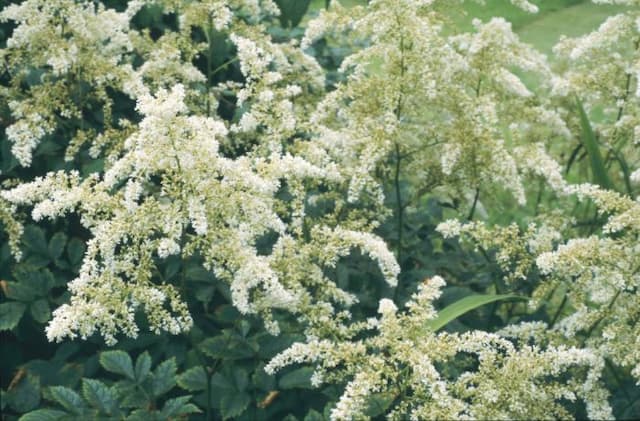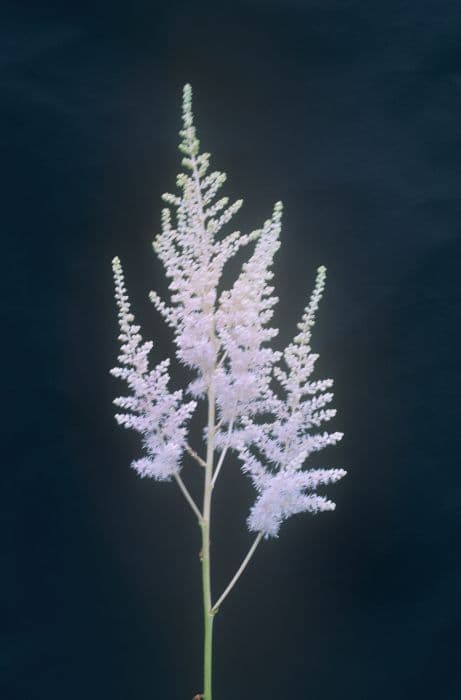Chinese Astilbe Astilbe chinensis

ABOUT
Astilbe chinensis, also known as Chinese astilbe, is a perennial plant renowned for its striking feathery plumes of flowers that give a fluffy appearance. These flower plumes range in color from white and light pink to various shades of purple and red. The blossoms appear on upright, arching stems that rise above the plant's foliage. Each plume consists of numerous tiny, starry flowers tightly clustered together, creating a dense, feathery spray. The foliage of Chinese astilbe is deeply divided, fern-like, and often carries a glossy sheen. The leaves can have a rich green color, which forms a beautiful backdrop for the colorful plumes. Some variations of the plant may have reddish or bronze-tinted leaves, adding to the ornamental appeal. The plant is typically seen with a mound-forming habit, forming clumps of these attractive leaves and flower stems. It provides a lush, textured effect in garden spaces, which is appreciated for its aesthetic appeal and contrast with other plants in a garden setting. Chinese astilbe is also known to attract pollinators like bees and butterflies, which are drawn to the abundant flowers for nectar. Overall, it is a graceful choice for adding softness and color to shaded or partially shaded garden beds and borders, being equally striking when planted en masse or as an individual specimen.
About this plant
 Names
NamesFamily
Saxifragaceae
Synonyms
Chinese Astilbe, False Goat's Beard, False Spirea
Common names
Astilbe chinensis var. pumila, Astilbe davidii, Astilbe grandis, Astilbe pumila, Astilbe rivularis, Astilbe rubra, Astilbe wilsonii.
 Toxicity
ToxicityTo humans
Astilbe, specifically Astilbe chinensis, is not known to be toxic to humans. This ornamental plant is generally considered safe and there are no common reports of poisoning upon ingestion. However, it is always advisable to avoid eating any part of ornamental plants due to potential individual allergic reactions or unknown sensitivities.
To pets
Astilbe, including the Astilbe chinensis variety, is also not known to be toxic to pets such as dogs and cats. This plant is usually considered non-toxic to animals and is not expected to cause symptoms of poisoning if ingested. Nonetheless, while Astilbe is safe for pets, it is still best practice to prevent pets from consuming plants as it may cause gastrointestinal discomfort or an individual adverse reaction.
 Characteristics
CharacteristicsLife cycle
Perennials
Foliage type
Deciduous
Color of leaves
Green
Flower color
Varies
Height
2 feet (60 cm)
Spread
2 feet (60 cm)
Plant type
Herb
Hardiness zones
4
Native area
China
Benefits
 General Benefits
General Benefits- Astilbe chinensis, commonly known as Chinese astilbe, adds ornamental value to gardens with its feathery plumes of flowers that come in a range of colors including pink, white, and lavender.
- Chinese astilbe is suitable for shaded to partially shaded areas, providing gardeners with a flowering option for parts of the garden that receive less sunlight.
- The plant's foliage also contributes aesthetic appeal, featuring fern-like leaves that add texture and contrast to garden settings.
- Chinese astilbe has a clumping habit which makes it effective for mass plantings, borders, or as a ground cover, helping to reduce soil erosion.
- It is known to attract pollinators such as bees and butterflies, supporting biodiversity in the garden ecosystem.
- The plant is deer and rabbit resistant, making it a good choice for gardens in areas with high wildlife presence.
- Chinese astilbe is relatively low maintenance, requiring minimal care beyond regular watering, and is resistant to most pests and diseases.
 Medical Properties
Medical Properties- Anti-inflammatory: Astilbe chinensis contains compounds that may help reduce inflammation in the body.
- Antibacterial: Extracts from the plant have shown potential antibacterial properties in some studies.
- Analgesic: There is some evidence to suggest that Astilbe chinensis might have pain-relieving properties.
- Antioxidant: The plant may have antioxidant effects, which can help in preventing damage caused by free radicals.
 Air-purifying Qualities
Air-purifying QualitiesThis plant is not specifically known for air purifying qualities.
 Other Uses
Other Uses- Floral Arrangements: Astilbe chinensis, commonly known as Chinese Astilbe, is often used in both fresh and dried floral arrangements due to its feathery plumes of flowers that add texture and interest.
- Shade Garden Accent: Chinese Astilbe is ideal for adding color and vibrancy to shaded garden spots, where other flowering plants might struggle to thrive.
- Craft Projects: The dried flower stalks can be used in a variety of craft projects, including wreaths and other decorative items.
- Living Borders: With its clumping growth habit, Chinese Astilbe can be planted in a row to create a living, flowering border in the garden.
- Ground Cover: In suitable climates and settings, Astilbe chinensis can be used as a ground cover plant, suppressing weeds and adding foliage interest.
- Erosion Control: Its robust root system helps to stabilize soil and can be used on slopes or areas prone to erosion.
- Fairy Gardens: The miniature varieties of Chinese Astilbe are popular in fairy gardens for their delicate appearance and varied colors.
- Rain Gardens: Chinese Astilbe can be planted in rain gardens due to its tolerance for moist soil conditions.
- Photography Backdrop: The plant’s lush foliage and feathery blooms provide a picturesque backdrop for garden photography.
- Education: Chinese Astilbe can be used as an educational tool in horticulture classes to teach about planting in shade and soil moisture requirements.
Interesting Facts
 Feng Shui
Feng ShuiThe Chinese Astilbe is not used in Feng Shui practice.
 Zodiac Sign Compitability
Zodiac Sign CompitabilityThe Chinese Astilbe is not used in astrology practice.
 Plant Symbolism
Plant Symbolism- Patient Love: Astilbe chinensis, commonly called the Chinese Astilbe, often symbolizes patient and enduring love due to its nature of slow growth and its ability to wait for the right conditions to bloom.
- Hope and Positive Vibes: With its feathery plumes, it is thought to bring hope and uplift spirits, making it a symbol for positivity.
- Dedication and Commitment: The plant's requirement for consistent moisture reflects the idea of being dedicated to nurturing relationships and commitments thoroughly and attentively.
- Beauty and Elegance: The elegant shape and form of its blooms symbolize a sense of refined beauty and sophistication.
- Protection and Safety: It is also associated with a harbinger of safety, as its dense foliage is thought to symbolize shelter and protection.
 Water
WaterFalse Spirea prefers consistently moist soil; it is vital to water it regularly, particularly during dry periods. Aim to water the plant deeply about once or twice a week, providing about 1 to 1.5 gallons per watering session to ensure the soil remains moist but not waterlogged. During hotter months, you may need to increase the frequency to maintain adequate moisture levels, while during cooler seasons or rainy periods, you can reduce the frequency. Avoid overhead watering to prevent foliar diseases; instead, water at the soil level.
 Light
LightFalse Spirea thrives in partial shade to full shade; however, it does appreciate some morning sun in cooler climates. The ideal spot for this plant is one where it can be protected from the harsh afternoon sun, especially in warmer regions. Ensure the location offers filtered light or dappled shade throughout the day for optimal growth.
 Temperature
TemperatureFalse Spirea does well in a wide range of temperatures, but it prefers cooler conditions. The plant can typically withstand temperatures as low as 20°F and as high as 75°F. The ideal temperature range for False Spirea is between 60°F and 70°F, where it can flourish without experiencing heat stress or frost damage.
 Pruning
PruningPruning False Spirea is necessary to maintain its shape, remove dead or faded flowers, and encourage bushier growth. The best time to prune is after the flowers have faded in late summer or early fall, cutting back the spent flower stalks and any dead or damaged stems. Generally, pruning once a year is sufficient; however, avoid heavy pruning as this can reduce the flowering in the next season.
 Cleaning
CleaningAs needed
 Soil
SoilChinese Astilbe thrives best in rich, moist, and well-draining soil with a pH of 6.0 to 8.0. An ideal soil mix can be made by combining garden soil, compost, and peat moss to enhance fertility and moisture retention.
 Repotting
RepottingChinese Astilbe typically does not need to be repotted often, as it prefers to be left undisturbed. Repotting can be done every 2 to 3 years or when the plant outgrows its current container.
 Humidity & Misting
Humidity & MistingChinese Astilbe prefers a high humidity environment, ideally above 60%, which mimics its natural habitat in woodlands and by stream banks.
 Suitable locations
Suitable locationsIndoor
Keep Chinese Astilbe in bright, indirect light and high humidity.
Outdoor
Plant Chinese Astilbe in partial shade and moist soil.
Hardiness zone
4-8 USDA
 Life cycle
Life cycleAstilbe chinensis, commonly known as Chinese Astilbe, begins its life cycle when the seeds are sown or mature clumps are divided and transplanted in the spring. The seeds germinate, and the seedlings establish a rosette of compound leaves, with growth accelerating as temperatures rise. As the plant matures, it develops woody crowns and a fibrous root system that anchors it into the soil. During late spring to midsummer, the Chinese Astilbe enters its flowering stage, producing feathery plumes of tiny flowers that can vary in color from white and pink to deep purples and reds, attractive to pollinators. After pollination, the flowers develop into dry capsules containing numerous small seeds. As autumn arrives, the above-ground foliage dies back, and the plant enters a period of dormancy over winter, relying on the energy stored in its roots to survive until the next growing season.
 Propogation
PropogationPropogation time
Spring to early summer
Propogation: Astilbe chinensis, commonly known as Chinese astilbe, is best propagated through division, which is a popular and efficient method for this perennial plant. The optimal time for dividing Chinese astilbe is in the spring or early fall, when the plant is not in active bloom. To propagate by division, carefully dig up the established clump after flowering has finished or before new growth begins. Using a sharp spade or knife, divide the clump into smaller sections, ensuring that each division has at least 2-3 growth buds. Replant the divisions immediately, spacing them approximately 18 to 24 inches (45 to 60 cm) apart, and water them thoroughly to help establish root growth. This method allows gardeners to quickly and easily expand their Chinese astilbe collection or share plants with others.









